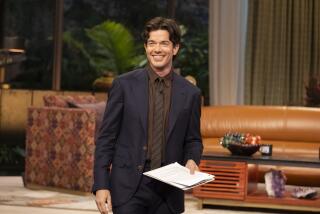Trio of L.A. riot documentaries look back to 1992
It’s been 25 years since Los Angeles went up in flames following the acquittal of four LAPD officers in the beating of unarmed black motorist Rodney King.
Now the L.A. riots are the subject of at least five documentaries that will air on cable and network television throughout the month.
In commemorating the anniversary of this critical chapter in L.A.’s history, each film takes a different angle in exploring the six-day uprising that took 55 lives, injured thousands and cost at least a billion dollars in damages.
Through new interviews, old news footage and camcorder-shot videos, filmmakers examine the circumstances before, during and after the citywide riots. The stories they tell resonate today and show us how far America has — and hasn’t — come since April 29, 1992.
Here is a look at three of the documentaries airing in the next week.
“L.A. Burning: The Riots 25 Years Later” (A&E, premieres Tuesday, April 18, 9 p.m.)
Director John Singleton, already Oscar-nominated for “Boyz n the Hood” when the riots occurred, is an executive producer, and in front of the camera as well, for this two-hour film directed by One9 and Erik Parker. (The pair previously collaborated on the documentary “Nas: Time Is Illmatic.”)
It naturally enough bookends the riots with recent clips from what feels like an epidemic of brutal, sometimes fatal encounters between black citizens and police officers too rarely held to account. But its strength is that it keeps its account first-person and personal, listening to participants, victims, close observers and others overtaken in the action, most filmed on the streets where it happened, and in some cases happened to them.

One9 and Parker give individual human context to their interlocking history. This is a serious, pointedly handsome work — Frank Larson was the director of photography — that balances crisp, quiet new footage with fuzzy, chaotic old. And if there are perhaps too many shots of subjects staring thoughtfully into the middle distance or darkly into the lens, the effect of their being filmed dignifies each speaker. You can decide for yourself whom to respect — here and there self-reflection shades into self-justification. The directors allow you that room. (R.L.)
“Burn ... Burn!” (Showtime, premieres Friday, April 21, 9 p.m.)
The full title of this 90-minute film is unprintable, but documentarian Sacha Jenkins (“Fresh Dressed”) focuses on the history of the LAPD and its relationship with the black and brown communities of Los Angeles.
Dating back to the deadly 1962 raid on a Nation of Islam mosque, “Burn” covers the rise of militarized law enforcement tactics by Police Chief William Parker, the ’65 Watts riots, the street gangs of 1970s and ’80s South Central, crack cocaine and Parker’s protégé, Chief Daryl Gates, who was at the helm during the ’92 riots.
Through a series of interviews with historians, civil rights leaders, citizens and former and present-day law enforcement (including current LAPD Chief Charlie Beck), the Showtime film paints a picture of a city divided — where whites were protected and blacks were kept away from the whites.
There were few opportunities for blacks who’d come to L.A. from the South in the ’50s, explain expert voices such as gang historian Alex Alonso and civil rights attorney Connie Rice. Forty years of discrimination, a high unemployment rate and brutal police tactics created the volatile cocktail that led to the ’92 riots.
Others interviewed here include rapper Dee Barnes, retired LAPD officers who worked the Watts riots, a former Black Panther and residents of South L.A. who were at Florence and Normandie when the intersection became one of the earliest flashpoints. (“We were sick and tired of being sick and tired, and we weren’t going to take it any more,” said one man of why Angelenos began burning, beating and looting.)
The film opens and closes with cellphone video of the 2015 shooting of an unarmed homeless man on skid row by LAPD. It makes the point that the more things change, the more they stay the same. “In the last four years,” says Black Lives Matter co-founder Patrisse Cullors, “we have had some of the most officer-involved shootings that have resulted in deaths in Los Angeles.” (L.A.)
“The Lost Tapes: L.A. Riots” (Smithsonian Channel, premieres Sunday, April 23, 8 p.m.)
Learned reflection gives history context but sometimes at the expense of immediacy; perspective is enlightening but can also be deadening, draining the life out of history.
This 60-minute film — part of a series that also includes episodes on Pearl Harbor, the Son of Sam murders and the Patty Hearst kidnapping — tells its story almost entirely through archival news reports, home video and photographs.
Some clips inevitably also appear in “L.A. Burning” and other riot-themed documentaries; but some, including LAPD-shot video footage, fire department dispatch chatter and listener calls to the Compton-based KJLH Radio, which give breadth to community concern, are exclusive to this film.
“The Lost Tapes” puts you in the heated moment, takes you along on a developing story purposely told without the benefit of hindsight; it is all reaction and little reflection, but no less complex a narrative for all that. Its only defect is a soundtrack/sound design that goes too readily to the tropes of reality television to create tension. “Lost Tapes” doesn’t need that help. (R.L.)
Follow Robert Lloyd on Twitter @LATimesTVLloyd
More to Read
The complete guide to home viewing
Get Screen Gab for everything about the TV shows and streaming movies everyone’s talking about.
You may occasionally receive promotional content from the Los Angeles Times.








